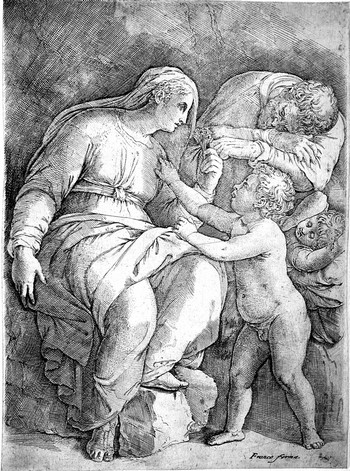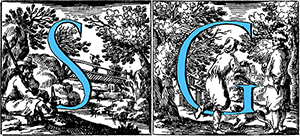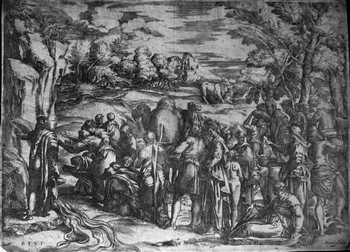
FRANCO Giovanni Battista
“il Semoleo” (Udine ? 1510 – Venice 1561)
Battista Franco dei Franchi nicknamed Semoleo (or Semolei) was a painter and Italian engraver. Son of Iacopo, he was born in Udine (or in Venice) probably around 1510.
In his biography Giorgio Vasari writes that at twenty he settled in Rome where he began to copy from contemporaries, especially Michelangelo. G.B. Franco performed his artistic activity above all in the papal town but also in Florence and Urbino, where he was fascinated by the Mannerism of central Italy.
From the fourth decade of the 16th century, the artist chose Michelangelo as his favorite model, and he was influenced by the subjects of the Master at the point to, according to Vasari, perform a very beautiful drawing of the Universal Judgment. After the Marche period in which he turned his attention to Raffaello and Titian, the frescoes of the chapel Gabrielli in the church of Santa Maria sopra Minerva in Rome (which was the best work done by Franco, according to Vasari ) marked the return of the artist to the Michelangelo of the Sistine chapel.
Nevertheless, in his prints it is possible to see the formal ideas contained in the frescoes by other authors admired in Vatican, especially Giulio Romano’s. There is a remaining example in Mantua, where he reproduced with slight modifications Giulio’s inventions visible in frescoes at the Palazzo Tè. He returned to Venice in 1552, where he remained until his death. In Venice Semoleo worked on the decoration of the Marciana Library (1556) and on those of the vault of the Scala d’oro at Palazzo Ducale before dedicating himself to the frescoes of Villa Foscari at Malcontenta where the Michelangelo influence emerged again. He died in Venice in 1561.


